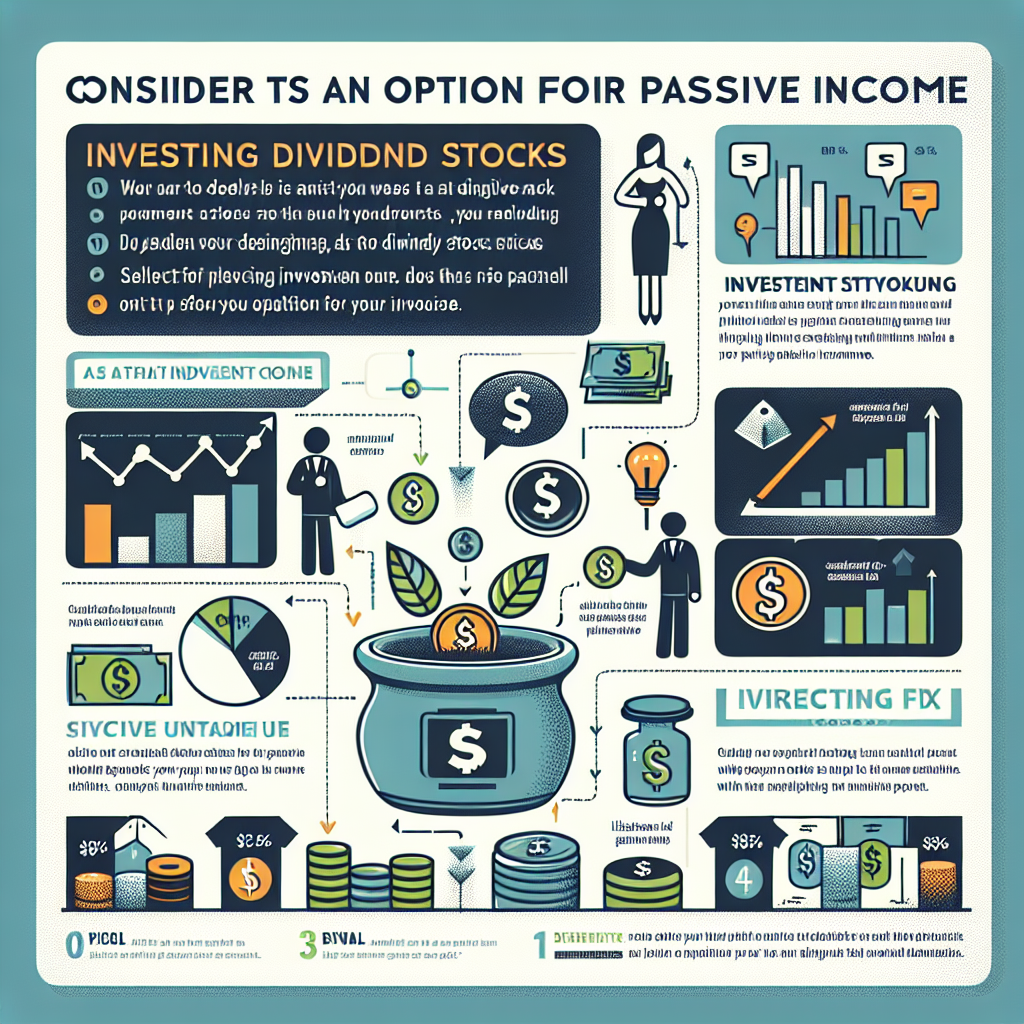Investing In Dividend Stocks: A Passive Income Strategy

Are you looking for a reliable and low-maintenance way to generate some extra income? Look no further than investing in dividend stocks. By investing in dividend stocks, you can create a passive income stream that provides you with regular payments just for being a shareholder. This article will guide you through the basics of dividend stocks and show you how they can be a great strategy for boosting your income without much effort. So sit back, relax, and let’s explore the world of passive income through investing in dividend stocks!
What are Dividend Stocks?
Dividend stocks are stocks that pay regular dividends to their shareholders. Dividends are a portion of a company’s earnings that are distributed to its shareholders as a way to share its profits. When you own shares of a dividend stock, you receive a portion of the company’s earnings on a regular basis, usually quarterly or annually. These dividends can provide a steady stream of income for investors.
Definition of Dividend Stocks
Dividend stocks, as the name suggests, are stocks that pay dividends. A dividend is a payment made by a company to its shareholders that represents a portion of the company’s profits. Dividend stocks are often sought after by investors looking for a regular income stream from their investments. These stocks are typically issued by mature, stable companies that generate consistent profits.
Types of Dividend Stocks
There are several types of dividend stocks that investors can choose from. The most common types include:
-
Blue-Chip Dividend Stocks: These are stocks of large, well-established companies with a history of stable and reliable dividend payments. Examples of blue-chip dividend stocks include Coca-Cola, Johnson & Johnson, and Procter & Gamble.
-
High-Yield Dividend Stocks: These stocks offer higher dividend yields compared to the broader market. However, they often come with higher risks as well. High-yield dividend stocks can be attractive to investors seeking higher income, but it’s important to carefully evaluate the company’s financial health before investing.
-
Dividend Growth Stocks: These stocks may not have the highest current yield, but they have a track record of consistently increasing their dividend payments over time. Dividend growth stocks can be a good choice for investors who are looking for both income and potential capital appreciation.
-
Real Estate Investment Trusts (REITs): REITs are companies that own and operate income-generating real estate properties. They are required by law to distribute a significant portion of their income to shareholders in the form of dividends. REITs can be a way to invest in real estate without the need for directly owning properties.
Benefits and Risks of Dividend Stocks
Investing in dividend stocks can offer a range of benefits, but it also comes with its own set of risks and considerations.
Benefits of Investing in Dividend Stocks
-
Steady Income: Dividend stocks provide a reliable income stream for investors, making them particularly appealing for those seeking a regular source of passive income.
-
Potential for Long-Term Growth: Many dividend stocks have a strong track record of increasing their dividends over time. By reinvesting dividends and taking advantage of compounding, investors can potentially grow their wealth over the long term.
-
Lower Volatility: Dividend-paying stocks tend to be more stable and less volatile compared to non-dividend-paying stocks. This can provide investors with a cushion during market downturns.
-
Inflation Hedge: Dividend payments have the potential to keep pace with inflation, providing investors with a hedge against the eroding value of money over time.
Risks and Considerations of Dividend Stocks
-
Interest Rate Sensitivity: Dividend stocks are sensitive to changes in interest rates. When interest rates rise, dividend stocks may become less attractive compared to other fixed-income investments.
-
Sector Risks: Investing heavily in one sector can expose investors to sector-specific risks. Diversifying across sectors can help mitigate this risk.
-
Dividend Cuts or Suspensions: Companies can reduce or eliminate their dividend payments, especially during economic downturns or financial difficulties. It’s important to conduct thorough research and choose financially sound companies with a history of stable dividends.
-
Market Risks: Like any other investment, dividend stocks are subject to general market risks. Market fluctuations, economic downturns, and geopolitical events can impact the overall performance of dividend stocks.

How to Identify Dividend Stocks
Identifying dividend stocks that fit your investment goals requires a systematic approach. Consider the following criteria when selecting dividend stocks:
Criteria for Selecting Dividend Stocks
-
Dividend Yield: Look for stocks with a reasonable dividend yield, but be cautious of excessively high yields, which may indicate potential risks or a company in distress.
-
Dividend Growth: Research the company’s track record of dividend growth. Choosing stocks that consistently increase their dividends over time can help protect against inflation and potentially increase your income.
-
Financial Health: Evaluate the company’s financial health by analyzing its balance sheet, cash flow, and profitability. A financially stable company is more likely to sustain its dividend payments.
-
Industry and Competitive Position: Take into account the company’s industry and competitive position. A company operating in a stable industry with a strong competitive advantage is more likely to generate consistent earnings and dividends.
Researching Dividend Stocks
To gather information on potential dividend stocks, you can utilize various research resources, including:
-
Company Financial Statements: Review the company’s annual reports, quarterly earnings reports, and other financial statements to assess its financial health and dividend history.
-
Dividend Aristocrats and Dividend Kings Lists: These lists classify companies that have consistently increased their dividends for a certain number of years. Researching companies on these lists can provide a starting point for identifying dividend stocks.
-
Financial News and Analysis: Stay informed about market trends, company news, and expert analysis through financial news websites, investment publications, and research reports.
-
Stock Screeners: Use online stock screeners to filter stocks based on specific dividend criteria, such as dividend yield, dividend growth rate, and payout ratio. This can help narrow down the list of potential dividend stocks.
Dividend Yield and Dividend Growth
Understanding the concepts of dividend yield and dividend growth is important for assessing the potential income and long-term growth prospects of dividend stocks.
Understanding Dividend Yield
Dividend yield is a measure of the annual dividend payment relative to the stock price. It represents the percentage return an investor can expect to receive from dividends alone. Dividend yield is calculated by dividing the annual dividend per share by the stock price.
A higher dividend yield indicates a higher income potential, but it’s essential to consider other factors, such as the company’s financial health and dividend sustainability. A very high yield can sometimes be a warning sign of potential risks.
Importance of Dividend Growth
Dividend growth is the annual rate at which a company increases its dividend. Dividend growth is an important factor to consider for long-term investors seeking to protect their income against inflation and potentially increase their total returns.
Companies that consistently increase their dividends demonstrate strong financial performance, stability, and shareholder-friendly policies. Dividend growth can contribute significantly to the total return on investment, especially when combined with reinvesting dividends.

Tax Considerations for Dividend Stocks
When investing in dividend stocks, it’s important to understand the tax implications associated with dividend income.
Dividend Taxation
Dividend income is generally taxed differently than ordinary income. The tax rates on dividends depend on whether they are qualified or non-qualified dividends.
Qualified dividends are generally taxed at preferential rates, which are lower than ordinary income tax rates. To qualify for the lower rates, dividends must meet specific holding period requirements and be paid by eligible U.S. corporations or qualified foreign companies.
Non-qualified dividends are taxed at ordinary income tax rates, which can be higher than the rates for qualified dividends.
It’s important to consult with a tax professional to understand the specific tax rules and implications based on your jurisdiction and individual circumstances.
Strategies to Minimize Taxes on Dividends
Several strategies can be employed to minimize the taxes on dividend income:
-
Invest in Tax-Advantaged Accounts: Consider investing in tax-advantaged accounts such as Individual Retirement Accounts (IRAs) or Roth IRAs. These accounts offer tax advantages that can help shelter dividend income from immediate taxation.
-
Focus on Qualified Dividends: Favor investing in stocks that pay qualified dividends to take advantage of the preferential tax rates.
-
Tax-Loss Harvesting: Consider offsetting taxable dividend income with capital losses from other investments. This strategy involves selling investments with capital losses to offset any capital gains or dividend income.
-
Donation of Dividends: If you have a philanthropic inclination, consider donating dividend income to qualified charitable organizations. This can potentially provide a tax deduction while supporting causes you care about.
Building a Dividend Portfolio
Building a dividend portfolio involves carefully selecting dividend stocks that align with your investment goals and diversifying across different sectors and industries.
Determining Your Investment Goals
Before building a dividend portfolio, it’s important to determine your investment goals. This includes defining your desired level of income, considering your risk tolerance, and understanding your time horizon for investments.
Investment goals will guide your selection of dividend stocks and help you create a portfolio that meets your specific needs.
Diversification with Dividend Stocks
Diversification is the practice of spreading investments across different assets, industries, and sectors to reduce risk. When building a dividend portfolio, diversification is important to mitigate the impact of any individual stock’s decline in performance.
Diversification can be achieved by investing in dividend stocks from different sectors and industries, such as healthcare, technology, consumer goods, and finance. By diversifying, you can potentially reduce the risk of loss and increase the likelihood of consistent dividend income.

Dividend Reinvestment Plans (DRIPs)
Dividend Reinvestment Plans (DRIPs) are a popular method for reinvesting dividend income back into shares of the issuing company.
Explanation of DRIPs
DRIPs allow investors to automatically reinvest cash dividends into additional shares of the company’s stock. This allows for compounding of dividends over time, potentially leading to exponential growth in investment value.
DRIPs typically offer investors the option to reinvest dividends at little or no cost, and some companies even offer additional discounts on shares purchased through DRIPs.
Pros and Cons of DRIPs
There are several advantages and disadvantages to consider when evaluating whether to participate in DRIPs:
Pros:
-
Compounding Growth: DRIPs allow investors to compound their dividends over time, potentially leading to increased wealth accumulation.
-
Ease of Investment: DRIPs provide a convenient way to automatically reinvest dividends without incurring transaction costs or needing to actively manage the reinvestment process.
-
Lower Cost Basis: Reinvesting dividends through DRIPs can reduce the average cost per share, which may lower the capital gains tax liability when shares are eventually sold.
Cons:
-
Lack of Flexibility: Participating in a DRIP means dividends are automatically reinvested, limiting the ability to use the cash for other investment opportunities or personal needs.
-
Tax Considerations: Reinvested dividends are still subject to taxation, even though they are not received as cash. It’s important to account for the tax implications of reinvested dividends.
-
Emphasis on a Single Company: By participating in a DRIP, a significant portion of the investment may be concentrated in a single company. This lack of diversification increases exposure to company-specific risks.
Dividend Aristocrats and Dividend Kings
Dividend Aristocrats and Dividend Kings are prestigious designations given to companies that have a strong track record of increasing their dividends over time.
Definition of Dividend Aristocrats
Dividend Aristocrats are S&P 500 Index constituents that have increased their dividends for at least 25 consecutive years. These companies are widely recognized for their ability to generate consistent earnings and distribute growing dividends to shareholders.
Dividend Aristocrats are often favored by income-seeking investors due to their history of stable and reliable dividend payments.
Definition of Dividend Kings
Dividend Kings are an elite subset of Dividend Aristocrats. To qualify as a Dividend King, a company must have increased its dividend for at least 50 consecutive years.
Dividend Kings represent the pinnacle of dividend growth and stability, inspiring confidence in their ability to weather economic downturns and consistently reward shareholders with increasing dividends.

Dividend Stocks vs. Growth Stocks
Dividend stocks and growth stocks represent different investment strategies, each with its own set of advantages and considerations.
Understanding the Difference
Dividend Stocks: Dividend stocks are stocks that distribute a portion of their earnings to shareholders in the form of regular dividends. These stocks are typically issued by established, mature companies that generate consistent profits.
Growth Stocks: Growth stocks, on the other hand, are stocks of companies that are expected to grow at an above-average rate compared to the market or their industry peers. These companies generally reinvest their earnings back into the business to fuel expansion and development.
Benefits of Dividend Stocks over Growth Stocks
-
Steady Income: Dividend stocks provide a regular and reliable income stream, making them attractive to investors seeking passive income.
-
Lower Volatility: Dividend stocks are often less volatile compared to growth stocks, providing investors with a more stable investment option.
-
Potential for Price Appreciation: Even though the primary focus of dividend stocks is income generation, they can still provide potential price appreciation over time as the company grows.
-
Income in Retirement: Dividend stocks can be an attractive option for retirees, as they offer a consistent income stream that can help support living expenses.
It’s important to note that dividend stocks and growth stocks can coexist within a well-diversified portfolio, allowing investors to benefit from both income and potential capital appreciation.
Strategies for Maximizing Dividend Income
Maximizing dividend income requires an understanding of various strategies and approaches. Here are two approaches to consider:
Dividend Capture Strategy
The dividend capture strategy involves purchasing a dividend stock just before its ex-dividend date and selling it shortly after receiving the dividend payment. This strategy aims to capture the dividend income while potentially minimizing the risk of price fluctuations.
While the dividend capture strategy can generate short-term income, it requires careful timing and monitoring of dividend payment dates. It’s important to note that this strategy may not be suitable for long-term investors focused on income and capital appreciation.
Creating a Strategy for Reinvesting Dividends
Reinvesting dividends is a common approach to maximize long-term income and potential growth. By reinvesting dividends, investors can compound their returns, potentially increasing wealth over time.
There are several strategies for reinvesting dividends:
-
Full Dividend Reinvestment: Reinvest the entire dividend amount back into the same stock or a different dividend-paying stock. This strategy can help accelerate the growth of the investment portfolio.
-
Partial Dividend Reinvestment: Reinvest a portion of the dividend while keeping the remainder as cash. This strategy allows for some liquidity while still taking advantage of the power of reinvesting dividends.
-
Selective Dividend Reinvestment: Utilize the dividend income to selectively invest in other attractive opportunities. This strategy involves analyzing potential investments and allocating dividend income to the most promising options.
Each reinvestment strategy has its own advantages and considerations, and the choice ultimately depends on individual investment goals and risk tolerance.
In conclusion, investing in dividend stocks can be a valuable strategy for generating passive income and potentially growing your wealth over time. By understanding the different types of dividend stocks, assessing the benefits and risks, and implementing effective strategies, you can build a dividend portfolio that aligns with your financial goals. Remember to conduct thorough research, assess your own investment objectives, and consult with financial professionals when needed to make informed investment decisions.




Leave a Reply